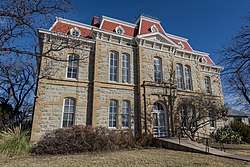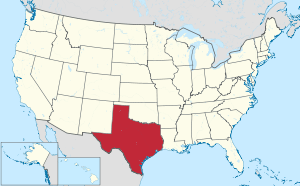Concho County, Texas
Concho County is a county located on the Edwards Plateau in the U.S. state of Texas. As of the 2010 census, the population was 4,087.[1] Its county seat is Paint Rock.[2] The county was founded in 1858 and later organized in 1879.[3] It is named for the Concho River.
Concho County | |
|---|---|
 The Concho County Courthouse in Paint Rock | |
 Location within the U.S. state of Texas | |
 Texas's location within the U.S. | |
| Coordinates: 31°20′N 99°52′W | |
| Country | |
| State | |
| Founded | 1879 |
| Named for | Concho River |
| Seat | Paint Rock |
| Largest city | Eden |
| Area | |
| • Total | 994 sq mi (2,570 km2) |
| • Land | 984 sq mi (2,550 km2) |
| • Water | 9.9 sq mi (26 km2) 1.0%% |
| Population (2010) | |
| • Total | 4,087 |
| • Density | 4.2/sq mi (1.6/km2) |
| Time zone | UTC−6 (Central) |
| • Summer (DST) | UTC−5 (CDT) |
| Congressional district | 11th |
| Website | www |
History
Through the 1800s, Paleo-Indians lived in the county and left behind archaeological remains of a burned-rock midden. Athabascan-speaking Indians associated with the prehorse Plains culture live in this part of Texas. Later native inhabitants include Jumano, Tonkawa, Comanche and Lipan Apache.[4]
In 1847, John O. Meusebach sent surveyors into the area.[4] In 1849, Robert Simpson Neighbors lead a small expedition through the area.[4]
The Texas Legislature formed Concho County from Bexar County in 1858.[4]
In 1874, Ranald S. Mackenzie led a campaign to drive out remaining native peoples and established the Mackenzie Trail.[4] The county seat was formally established and named Paint Rock after the nearby pictographs.[5] The Eden community was established in 1882.[6] In 1909, the community of Lowake community was established.[7]
Railroad development
Railroads came to the county first in 1910, with the Concho, San Saba and Llano Valley railroad being completed to Paint Rock.[4] The Fort Worth and Rio Grande Railway is completed across the southeastern corner of the county in 1911,[4] and the Gulf, Colorado and Santa Fe railroad finished a line to Eden in 1912.[4]
By 1930, the area had 449 owner-operated farms and 682 tenant-operated farms, of whom 619 were sharecroppers.[4]
In 1940, Concho County became part of a soil-conservation district.[4] In 1985, the Texas Water Commission granted permission to impound 554,000 acre feet (683,000,000 m3) of water on the Colorado River at Stacy, to create the O. H. Ivie Reservoir.[8]
As of 1988, Concho County was the leading sheep-producing county in Texas.[4]
Geography
According to the U.S. Census Bureau, the county has a total area of 994 square miles (2,570 km2), of which 984 square miles (2,550 km2) is land and 9.9 square miles (26 km2) (1.0%) is water.[9]
Major highways




Adjacent counties
- Runnels County (north)
- Coleman County (northeast)
- McCulloch County (east)
- Menard County (south)
- Tom Green County (west)
Demographics
| Historical population | |||
|---|---|---|---|
| Census | Pop. | %± | |
| 1880 | 800 | — | |
| 1890 | 1,065 | 33.1% | |
| 1900 | 1,427 | 34.0% | |
| 1910 | 6,654 | 366.3% | |
| 1920 | 5,847 | −12.1% | |
| 1930 | 7,645 | 30.8% | |
| 1940 | 6,192 | −19.0% | |
| 1950 | 5,078 | −18.0% | |
| 1960 | 3,672 | −27.7% | |
| 1970 | 2,937 | −20.0% | |
| 1980 | 2,915 | −0.7% | |
| 1990 | 3,044 | 4.4% | |
| 2000 | 3,966 | 30.3% | |
| 2010 | 4,087 | 3.1% | |
| Est. 2019 | 2,726 | [10] | −33.3% |
| U.S. Decennial Census[11] 1850–2010[12] 2010–2014[1] | |||
As of the census[13] of 2000, 3,966 people, 1,058 households, and 757 families resided in the county. The population density was 4 people per square mile (2/km²). There were 1,488 housing units at an average density of 2 per square mile (1/km²). The racial makeup of the county was 88.20% White, 0.98% Black or African American, 0.48% Native American, 0.08% Asian, 0.10% Pacific Islander, 8.93% from other races, and 1.24% from two or more races. About 41.33% of the population were Hispanics or Latinos of any race.
Of the 1,058 households, 29.80% had children under the age of 18 living with them, 59.40% were married couples living together, 9.70% had a female householder with no husband present, and 28.40% were not families. About 26.60% of all households were made up of individuals and 14.20% had someone living alone who was 65 years of age or older. The average household size was 2.45 and the average family size was 2.97.
In the county, the population was distributed as 16.10% under the age of 18, 10.40% from 18 to 24, 38.20% from 25 to 44, 21.50% from 45 to 64, and 13.80% who were 65 years of age or older. The median age was 36 years. For every 100 females, there were 181.30 males. For every 100 females age 18 and over, there were 209.90 males.
The median income for a household in the county was $31,313, and for a family was $36,894. Males had a median income of $20,750 versus $21,458 for females. The per capita income for the county was $15,727. About 7.50% of families and 11.90% of the population were below the poverty line, including 15.80% of those under age 18 and 14.20% of those age 65 or over.
Concho County has the third-highest proportion of prison inmates amongst its residents of any county equivalent in the United States, behind Crowley County, Colorado and Louisiana’s West Feliciana Parish.[14][15] As a result the county has the highest gender ratio in the United States with 232 men to every 100 women.[16]
References in popular culture
The 1968 movie Journey to Shiloh features a group known as the "Concho County Comanches," and mentions neighboring Menard County.
Politics
| Year | Republican | Democratic | Third parties |
|---|---|---|---|
| 2016 | 82.9% 885 | 13.9% 148 | 3.3% 35 |
| 2012 | 79.2% 793 | 19.4% 194 | 1.4% 14 |
| 2008 | 74.9% 807 | 23.9% 257 | 1.2% 13 |
| 2004 | 76.4% 911 | 22.6% 270 | 1.0% 12 |
| 2000 | 74.2% 818 | 24.3% 268 | 1.5% 17 |
| 1996 | 47.3% 488 | 42.1% 434 | 10.7% 110 |
| 1992 | 33.5% 414 | 39.6% 489 | 26.9% 333 |
| 1988 | 48.9% 617 | 50.9% 643 | 0.2% 3 |
| 1984 | 58.3% 821 | 41.2% 580 | 0.5% 7 |
| 1980 | 49.4% 700 | 49.5% 702 | 1.1% 15 |
| 1976 | 39.7% 474 | 59.8% 715 | 0.5% 6 |
| 1972 | 67.0% 709 | 33.1% 350 | |
| 1968 | 37.0% 411 | 45.2% 502 | 17.8% 197 |
| 1964 | 24.4% 307 | 75.5% 948 | 0.1% 1 |
| 1960 | 42.0% 522 | 57.8% 718 | 0.2% 2 |
| 1956 | 50.3% 574 | 49.7% 567 | 0.1% 1 |
| 1952 | 53.3% 808 | 46.7% 708 | |
| 1948 | 12.9% 174 | 85.9% 1,156 | 1.2% 16 |
| 1944 | 11.1% 151 | 79.9% 1,090 | 9.0% 123 |
| 1940 | 12.6% 189 | 87.3% 1,310 | 0.1% 1 |
| 1936 | 6.5% 76 | 93.5% 1,089 | |
| 1932 | 3.8% 44 | 95.9% 1,126 | 0.3% 4 |
| 1928 | 51.0% 446 | 48.7% 426 | 0.3% 3 |
| 1924 | 11.5% 90 | 85.5% 668 | 2.9% 23 |
| 1920 | 22.4% 151 | 60.0% 405 | 17.6% 119 |
| 1916 | 7.1% 36 | 82.1% 418 | 10.8% 55 |
| 1912 | 4.3% 16 | 87.2% 326 | 8.6% 32 |
See also
References
- "State & County QuickFacts". United States Census Bureau. Archived from the original on February 27, 2016. Retrieved December 9, 2013.
- "Find a County". National Association of Counties. Archived from the original on 2011-05-31. Retrieved 2011-06-07.
- "Texas: Individual County Chronologies". Texas Atlas of Historical County Boundaries. The Newberry Library. 2008. Retrieved May 21, 2015.
- Standifer, Mary M. "Concho County, Texas". Handbook of Texas Online. Texas State Historical Association. Retrieved 30 November 2010.
- "Paint Rock Pictographs". Texas Beyond History. Retrieved 30 November 2010.
- "Eden, Texas". Texas Escapes. Texas Escapes - Blueprints For Travel, LLC. Retrieved 30 November 2010.
- "Lowake, Texas". Texas Escapes. Texas Escapes - Blueprints For Travel, LLC. Retrieved 30 November 2010.
- "O. H. Ivie Reservoir". Handbook of Texas Online. Texas State Historical Association. Retrieved 30 November 2010.
- "2010 Census Gazetteer Files". United States Census Bureau. August 22, 2012. Retrieved April 21, 2015.
- "Population and Housing Unit Estimates". United States Census Bureau. May 24, 2020. Retrieved May 27, 2020.
- "U.S. Decennial Census". United States Census Bureau. Retrieved April 21, 2015.
- "Texas Almanac: Population History of Counties from 1850–2010" (PDF). Texas Almanac. Retrieved April 21, 2015.
- "U.S. Census website". United States Census Bureau. Retrieved 2011-05-14.
- Wagner, Peter; ‘Twenty one counties have twenty one percent of their population in prisons and jails’; Prison Policy Initiative, April 19, 2004
- Prison Policy Initiative; ‘Racial Geography of Mass Incarceration – Appendix A. Counties: Ratios of overrepresentation’
- "Concho County, Texas Gender Ratio". States101.com. Retrieved 2015-12-20.
- Leip, David. "Dave Leip's Atlas of U.S. Presidential Elections". uselectionatlas.org. Retrieved 2018-07-20.
External links
![]()
